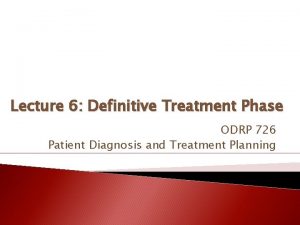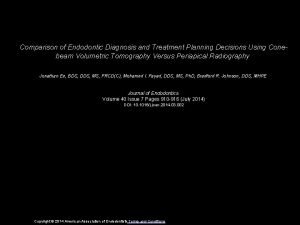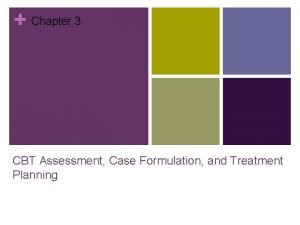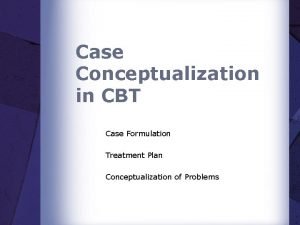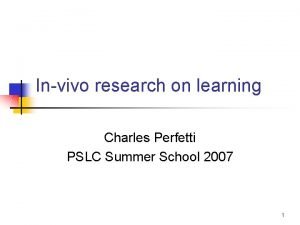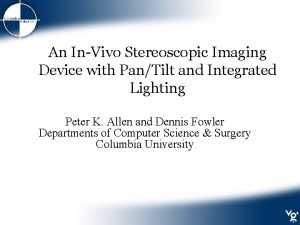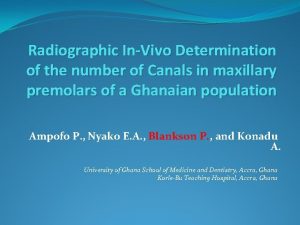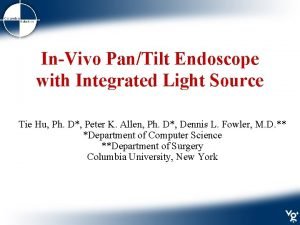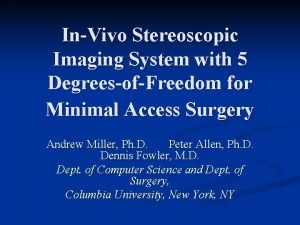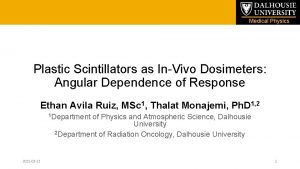A new treatment planning concept accounting for invivo















- Slides: 15

A new treatment planning concept accounting for in-vivo range verification in proton therapy Liheng Tian 1, Guillaume Landry 1, 2, Georgios Dedes 1, Florian Kamp 2, Marco Pinto 1, Claus Belka 2, 3, Katia Parodi 1 1 Ludwig-Maximilians-Universität München, Department of Medical Physics, Munich, Germany of Radiation Oncology, University Hospital, LMU Munich, Germany 3 German Cancer Consortium (DKTK), Munich, Germany 2 Department

Proton range uncertainty: • • CT number conversion Anatomical changes Patient set up …

Introduction In-vivo proton range verification • Prompt Gamma (PG) Imaging monitors the Prompt Gamma emitted by nuclear de-excitation of nuclei in the beam path Beam path Prompt gamma Detector

Introduction PG detectability and PG-dose correlation is not considered in current TPS: Tian et al, PMB 2018 The number of protons affects the PG falloff detection precision. 1. 35 e 8 is set as the statistical threshold in this work Pencil beams (PBs) may exhibit different PG-dose correlation

Introduction Previous study (based only on single CT image): Tian et al, PMB 2018 Position (mm) Tian et al, PMB 2018 Quantification of PG-dose correlation (slope, fall-offs distance, fitting error) Boost a few pencil beams (PBs) with good PG-dose correlation, evenly distributed across the treatment field, above the statistical detectability threshold

Introduction The laterally integrated PG signal could be used to estimate the shift of the proton range (80% distal dose fall-off) on different CTs However, the PG-dose correlation could be spoiled by anatomical changes. A PB for which the shift of the dose and PG match each other is believed to be reliable for PG-based proton range monitoring

Materials and methods A 2 D distal surface derived from 3 D dose distribution (this proposed idea is tested on one head and neck and one prostate patient): Std: 0. 03 mm Std: 0. 50 mm Std: 2. 80 mm The standard deviation (std) of the ranges of beamlets within the pencil beam (called dose surface in the following) is used to evaluate the effect of heterogeneities on 3 D dose distribution

Materials and methods TP re-optimization: PBs selected from recommendation Counter-indicated PBs PG-dose correlation Dose surface

Result Distribution of the total dose: The re-optimized TPs and the initial CERR TP are comparable in terms of total dose distribution

Result Distribution of the dose averaged LET: The re-optimized TPs and the initial CERR TP are comparable in terms of dose averaged LET distribution

Result PB boosted • The difference between the dose and PG • PBs recommended by the indicator are better

Result Comparison to PG aggregation: Another approach was proposed by another group to aggregate nearby PBs to reach enough statistics for PG detectability. • The range of aggregated PBs are different. A range mixing of 14. 6 mm is observed • The statistics of the aggregated PBs is still not guaranteed. The minimum aggregated statistics is 4 e 7 which is lower than the detectability threshold • The conformity of the dose and PG signal is not considered in the PB aggregation • There is no conflict between those two approaches as PG data of individual PBs could still be aggregated regardless whether PBs are boosted or not

Conclusion & outlook • Demonstrated proof-of-concept of new TPS approach accounting for PG monitoring • Our method favors PG detectability of selected spots, while maintaining similar quality in terms of dose and dose averaged LET distribution • Especially in presence of heterogeneities it can be superior to PB aggregation approach

This work is funded by EU-MSCA GA n. 675265 (OMA) and supported by the DFG Excellence Cluster “Munich Center for Advanced Photonics”

Thanks!
 Conservatism in accounting
Conservatism in accounting Royalty accounting
Royalty accounting In departmental account
In departmental account Aasb112
Aasb112 Vendor rebates accounting treatment
Vendor rebates accounting treatment Finance lease vs hire purchase accounting
Finance lease vs hire purchase accounting Phases of dental treatment planning
Phases of dental treatment planning Charting exercise chapter 28
Charting exercise chapter 28 Phases of dental treatment planning
Phases of dental treatment planning Diagnosis and treatment plan of complete denture
Diagnosis and treatment plan of complete denture Endodontic diagnosis and treatment planning
Endodontic diagnosis and treatment planning Cbt case conceptualization and treatment planning example
Cbt case conceptualization and treatment planning example Oral diagnosis and treatment planning ppt
Oral diagnosis and treatment planning ppt Impression for partial denture
Impression for partial denture Cbt case formulation example
Cbt case formulation example Iso 22301 utbildning
Iso 22301 utbildning








